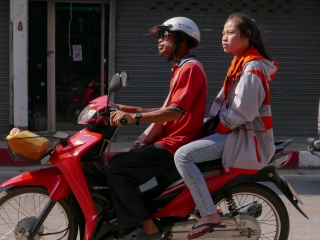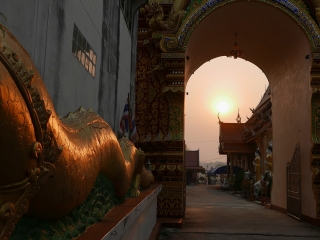It was 6:00 p.m., still light out and the Saturday Walking Street, one of Chiang Rai’s most popular night markets, was barely getting started. Hawkers were setting up their stalls and only a few visitors were walking around, slightly confused, as if witnessing a dress rehearsal. Suddenly, ceremonial music blasted from unseen loudspeakers. Everyone froze in their tracks, stood up straight and stopped whatever they were doing at the time. Not a single movement. The scene reminded me of a time freeze sci-fi movie.
I realized the tune was the Thai anthem and the locals were paying respect to it. Unsure what to do, I slowed down, slightly amused, just about to take out my camera and capture the strange sight. But a sensationalist photo is not necessarily a good photo, and I didn’t want to come off as an ignorant farang. So I stopped and listened too for the next few minutes, until the market resumed its pre-opening movements.
While perfecting the art of travel, I realized a true way to experience a Thai town is to check out its morning and night markets. Both represent, to me, the lifeblood of a place and its people. From one town to the next, both in Thailand and the countries I visited afterwards, these markets became the holy grail of my travel planning. I timed my arrival to a certain place based on the schedule of the local markets. I chose my accommodation depending on the distance to the markets. I adjusted my sleep accordingly. Above all, I did not mind spending two or even three different days exploring the same market, wandering aimlessly down the same alleys, noticing the changes in light and atmosphere, and finding comfort in the familiar faces and stalls. If short on time, I would unflinchingly choose a local market over a sight: the bustle of a market always offered more photo ops and unexpected discoveries.
Morning markets have a strong practical purpose—to provide the day’s food—and so they are transactional and hasty, both a sad and peculiar way to see the cycle of life over and over again (more about this in a future story). Night markets on the other hand belong to a different universe. They are a capstone to the (stifling) day and a celebration of life itself. Night markets are, above everything, social interaction, a place where differences of status disappear, where the day and its toils melt away, leaving behind the joy of living, manifested in the simplest (and sometimes kitschiest) of things. Visitors move about in big, noisy crowds, creating a sort of stream that carries you with it, allowing you to catch only fast-moving glimpses, little bits of life that make up a dizzying whole, one where everything is possible.
It’s difficult to write about a night market in particular, because each one is at the same time all those I’ve visited, a collection of sights, smells, tastes, interactions—the electrifying feeling of being among people, of relishing the crowd and its noise.
I always start by checking out the food on offer in a small area, for as long as I can stave off hunger, take a first snack along, or take a seat at a small plastic table if the dish is more substantial, there’s a whole family seated right next to me—people-watching only makes the experience better—move on, here is the textiles section, I need a new linen shirt but there are too many to choose from, maybe I could get a silly dog bonnet instead to send back home, here’s a kid watching cartoons on her parent’s phone behind a stall, here starts the massage section, with secluded spaces and the smell of aromatic balm, remember its location for later, here’s an open stage where people dance to Thai evergreens, grab more food and watch the whole thing for a while, time to get something to drink, here’s taro tea—strike up a conversation with the owner, find out he is my age and he decided to open a bubble tea business, realize I don’t have any small change, owner says “It’s okay, you can come back later to pay,”—here’s a blind person playing music on a portable piano to ask for money, I feel like I’ve encountered this person at every night market I’ve visited, here’s a man watching a football game on his phone while his wife is barely keeping up with client orders, but wait, here’s my favorite dessert for only 10 baht, caramelized coconut in glutinous rice wrapped in banana leaves, grab some while I watch some traditional dancers and call my family on skype to show them the whole thing live, go back to the taro tea seller and pay him the money, he almost refuses to receive it and says the tea was supposed to be a gift, here’s a stall with several tourists queuing, it must be one of those recommended by the guide books, here’s a stall with plastic trinkets in crazy colors, here are plastic bags cut in stripes and hung as insect repellent on makeshift fans, here are plastic bags filled with take-away food, just waiting to be picked up, others just being filled with hot bubbly fluid, how come they don’t melt, here are Thai women sealing plastic bags with rubber bands with the dexterity of magicians, I was never able to figure out their hand movements or remove the rubber band easily, here’s more and more food, in myriads of shapes and textures and temperatures, and the accompanying vast sight of satisfied eaters, contemplating food, picking through food, shoving it into their mouths, slurping from their bowls, splashing food onto their faces, talking and laughing over food—a self-sufficient, all-accommodating empire of food, where each participant, like each ingredient, mixes perfectly with the rest.
What partly distinguishes the Chiang Rai night market from this soup of memories was my attempt that evening to take hidden pictures. I held the camera around my waist, with my thumb pressing on the shutter, and locked the eyes of incoming people with my own eyes, to make them unaware of the camera. The market stretched along two long lanes, one for each way, and I sauntered down each lane against the stream, observing the faces of the people moving towards me. Not a single look of disapproval for how I jostled against everyone. And if only they knew I was at the same time snapping pictures, carried away by the desire to record everything.
It was almost closing time at the Saturday Walking Street. In a remote section of the market, another tune was blasting from unseen loudspeakers, this time cheesy Western music. A couple of transgender performers in flamboyant dresses were lip-syncing to the music. Their actual show seemed to have long ended, but they were having fun for the sake of their audience—a few tourists with cameras. I could’t take any more photos because I had already used up all the camera batteries during my massive photo shoot. But that was not a moment I really needed to record. Getting to see up close a few of the infinite simple moments and passing joys that make up a night market was more special.
I turned my back to the show and waltzed the rest of the way to the guesthouse.

















Leave a Reply